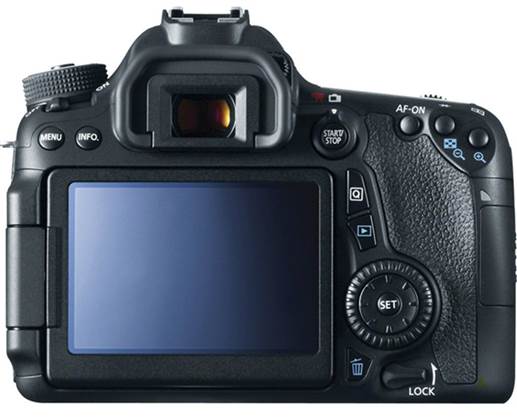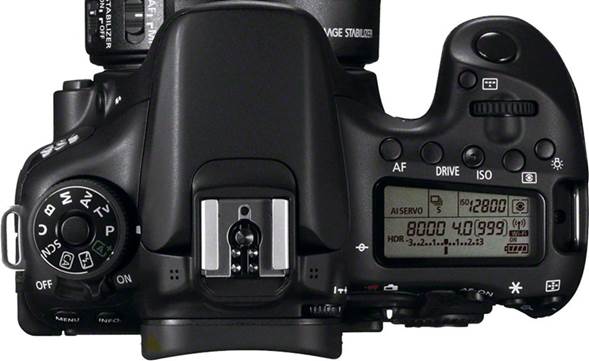The Canon EOS 70D succeeds the 60D, Canon’s prosumer-level
DSLR cameras which go against Nikon’s D7000-series. With its ability to shoot
up to seven 20MP frames per second, the 70D is currently Canon’s
highest-resolution APS-C DSLR, and the second-fastest behind the four-year old
7D’s eight frames-per-second maximum shooting speed.

Canon 70D camera
Whereas the Nikon D7100 went all-in for image quality with a
24MP sensor and the removal of the optical low-pass filter, Canon goes in with
features. The 20MP 70D comes with built-in Wi-Fi (the D7100 doesn’t), and a
brand new Dual Pixel CMOS AF system which promises better auto-focus
performance in Live View mode. It is disappointing though that while the D7100
has a magnesium alloy body which is both weather- and dust-sealed, the 70D has
neither.
The 70D doesn’t bring back the joystick from the 50D, plus
it makes switching AF points harder to do than the 60D. To switch AF area modes
you use the selection button in-between the shutter release and top dial.
However, if you’re out of Single-point or Zone AF, the AF point selection
button on the back now doesn’t let you quickly go into AF point selection,
unlike on previous Canons. There are 19 AF points, all cross-type, but they’re
bunched in the middle so there’s not a lot of coverage. If you’ve used the 7D
before, it’s exactly the same AF system.

Screen of Canon 70D camera
Other than that, everything falls into place quite nicely on
the 70D, with controls within easy reach and the top LED panel providing
essential info. The big UI improvements come with Live View and the capacitive
touch-screen; you can tap on anything in the menu. In addition, the ability to
use both the touch-screen and physical controls make it easier to adjust camera
settings. Canon’s Dual Pixel CMOS AF system makes its debut on the 70D. Whereas
Hybrid CMOS AF uses a combination of phase- and contrast-detection AF, AF is
calculated exclusively using phase-detection AF via Canon’s Dual Pixel
technology. On the 70D, Dual Pixel AF is a complementary technology; when you
shoot with the optical viewfinder the 70D will default to using conventional
phase detection AF, it’s when you switch to using Live View that Dual Pixel AF
kicks in.
Dual Pixel AF works to a degree. Auto-focus when shooting
movies is faster, and focus racks smoothly. It helps create buttery focus
transitions with a simple tap to focus on the Live View screen, and is vastly
better than previous DSLRs’ attempts at shooting movies with phase detection AF.
When it comes to shooting stills however, there’s still a split-second lag in
focus acquisition that you don’t see in the best mirrorless cameras today.

Canon separates AF area modes and
point selection with a new selection button just below the shutter release
Image quality is vivid, with clear ISO performance up to
about ISO 1600. It’s ISO 3200 when detail loss starts, but you can probably
reach up to ISO 6400 if necessary. There’s more chroma noise than expected, and
while ISO 12,800 looks mushy in our lab tests, you can get away if it in the
real world if it’s just for sharing at low resolutions. The 18-135mm kit lens
is a weak point; serviceable but none too sharp.
While the Canon 70D might not break new ground in terms of
imaging quality, it delivers a well-rounded package for shooting both stills
and video. Shooting stills in Live View is not as fast to focus as with the
best mirrorless cameras, but it makes smooth auto-focusing in video as easy as
it can be for non-professionals.
Specifications
·
Sensor: APS-C 22.5 x 15mm CMOS
·
AF Points: 19 (all cross-type)
·
ISO Sensitivity: ISO 100-12,800 (expandable to ISO
25,600)
·
Shutter Speeds: 1/8000 sec to 30 sec, Bulb
·
Flash Sync Speed: 1/250 sec
·
Continuous Shooting Speed: Max. approx. 7 shots/sec
·
Max. Movie recording size: 1080/30p/25p/24p
·
LCD Monitor: 3” TFT, approx. 1.04 million dots,
capacitive touchscreen
·
Battery Life: approx. 920 shots (with viewfinder), 210
shots (with Live View)
·
Weight: 755g
·
Megapixels: 20.2MP
·
Dimensions: 139 x 104.3 x 78.5 mm
·
Price: $1,499
|